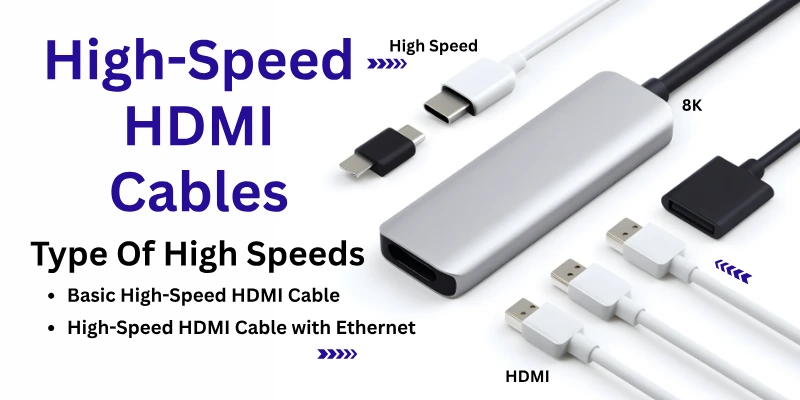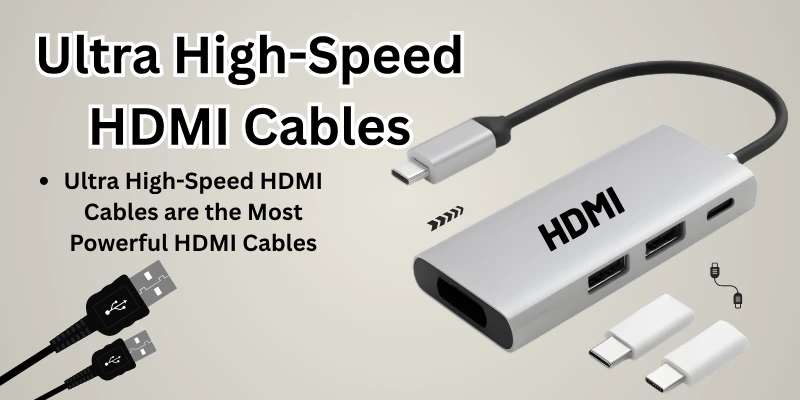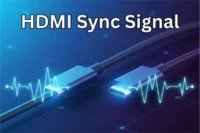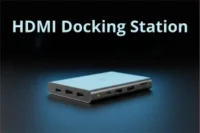HDMI Cable Types: Complete Guide
Published: 14 Aug 2025
Have you ever wondered why some HDMI (High-Definition Multimedia Interface) cables are expensive while others are cheap? Does it really make a difference?
Many people assume all HDMI cables are the same, but that’s not true. Different types of HDMI cables support different resolutions, speeds, and features. Using the wrong one can lead to blurry visuals, poor sound, or even connection issues. So, how do you know which one to buy?
Let’s break it down in simple terms.
HDMI Cable Types
Before choosing an HDMI cable, knowing the different types available is helpful. HDMI cables are grouped based on their version and how fast they can send signals (bandwidth).

Here is a list of all types of HDMI cables:
- Standard HDMI Cables
- High-Speed HDMI Cables
- Premium High-Speed HDMI Cables
- Ultra High-Speed HDMI Cable
- Specialized HDMI Cables
Keep reading to learn about the different kinds of HDMI cables.
1. Standard HDMI Cables
A standard HDMI cable is a special type of wire that connects devices like TVs, DVD players, and gaming consoles. It transfers both pictures and sound from one device to another.
Imagine you have a video game console, and you want to see the game on your TV. You need an HDMI cable to connect them so that the TV can display the game and play the sounds.
There are two types of standard HDMI cables:
- Basic Standard HDMI Cable
- Standard HDMI Cable with Ethernet
Let’s learn about both in a simple way!
1. Basic Standard HDMI Cable
This is the basic type of HDMI cable. It transfers video and sound between devices but works best for older TVs.
Resolution & Refresh Rate
- Supports 720p or 1080i resolution. (This means clear pictures, but not super sharp like 4K.)
- Works best with a refresh rate of 60 Hz. (Refresh rate means how smoothly the picture moves.)
Bandwidth
- Has a low bandwidth of about 4.95 Gbps (gigabits per second). (Bandwidth is how much data can travel through the cable at once.)
- This rating is good for watching movies and playing casual games, but not for high-speed action games or 4K videos.
HDMI Version Support
- It usually supports HDMI 1.0 to HDMI 1.2 versions. (Older versions of HDMI that work with old TVs and devices.)
How It Works
- Imagine you have a DVD player and want to watch a movie on your TV.
- You plug one end of the HDMI cable into the DVD player and the other end into the TV.
- Now, the movie appears on the TV, and you can hear the sound too!
What Can It Do
- Works well with older TVs (720p or 1080i resolution).
- Great for watching movies or playing games on simple setups.
- Cannot support very high-quality pictures like 4K or rapid refresh rates for high-speed gaming.
2. Standard HDMI Cable with Ethernet
This cable is just like the standard HDMI cable but with an extra feature—it can also carry internet signals!
Resolution & Refresh Rate
- Supports 720p or 1080i resolution, just like the standard HDMI cable.
- Works best with a 60Hz refresh rate, making it smooth for watching movies.
Bandwidth
- Same as the standard HDMI cable: 4.95 Gbps.
- Still not suitable for 4K or high-speed gaming.
HDMI Version Support
- Usually supports HDMI 1.4, which introduced Ethernet support. (This means it can carry the internet along with video and sound!)
How It Works
- Imagine you have a smart TV that needs the internet to watch YouTube.
- If your TV and another device (like a DVD player or gaming console) both support Ethernet HDMI, this cable can send internet signals along with video and sound.
- This means you don’t need extra internet cables—the HDMI cable does it all!
What Can It Do?
- Does everything a standard HDMI cable does.
- Allows some devices to share an internet connection without extra wires.
- Works best with 720p or 1080i picture quality.
- Cannot support 4K, high refresh rates, or very fast internet speeds.
Which One Should You Use?
- If you just want to watch movies or play games on an older TV, a standard HDMI cable is good enough.
- If your devices can share the internet, then a standard HDMI cable with Ethernet is the better choice.
2. High-Speed HDMI Cables
A high-speed HDMI cable is a better and faster type of HDMI cable compared to a standard HDMI cable. It can carry higher-quality pictures and sound, making it ideal for modern TVs, gaming consoles, and computers.

Imagine you want to play a video game on a big TV, and you want super sharp and smooth pictures. A high-speed HDMI cable is what you need!
There are two types of high-speed HDMI cables:
- Basic High-Speed HDMI Cable
- High-Speed HDMI Cable with Ethernet
Let’s learn about both in a simple way!
1. Basic High-Speed HDMI Cable
This is an advanced HDMI cable that supports better picture quality and faster refresh rates.
Resolution & Refresh Rate
- Supports 1080p, 1440p, and even 4K resolutions. (This means much clearer and sharper pictures!)
- Works well with refresh rates up to 120 Hz, making motion smoother in games and videos.
Bandwidth
- Has a higher bandwidth of 10.2 Gbps (gigabits per second). (This means it can send more data faster!)
- Better for gaming, high-quality movies, and fast-moving videos.
HDMI Version Support
- Supports HDMI 1.3 to HDMI 2.0 versions. (This makes it work with many modern devices!)
How It Works
- Imagine you have a gaming console and want to play a game on your TV.
- You plug one end of the high-speed HDMI cable into the gaming console and the other end into the TV.
- Now, the game looks super sharp and moves very smoothly!
What Can It Do
- Supports full HD (1080p) and even 4K resolution for sharper images.
- Works well with higher refresh rates (up to 120 Hz) for smoother motion.
- Great for gaming, watching movies, and high-quality videos.
- Cannot support 8K resolution or very high refresh rates like 240 Hz.
2. High-Speed HDMI Cable with Ethernet
This cable is just like the high-speed HDMI cable, but it has an extra feature—it can also carry internet signals!
Resolution & Refresh Rate
- Supports 1080p, 1440p, and 4K resolutions.
- Works with refresh rates up to 120 Hz (Great for smoother gaming and videos!)
Bandwidth
- Same as the High-Speed HDMI Cable: 10.2 Gbps.
- Can send video, sound, and internet signals through one single wire.
HDMI Version Support
- Supports HDMI 1.4 to HDMI 2.0, which introduced Ethernet support. (This means it can carry the internet along with video and sound!)
How It Works
- Imagine you have a smart TV that needs the internet to watch Netflix.
- If your TV and another device (like a Blu-ray player or gaming console) both support Ethernet HDMI, this cable can send internet signals along with video and sound.
- No need for extra internet cables—the HDMI cable does it all!
What Can It Do
- Supports full HD (1080p) and even 4K resolution.
- Works with higher refresh rates (up to 120 Hz) for smooth images.
- Can carry an internet connection between compatible devices.
- Cannot support 8K or the highest refresh rates (240 Hz or more).
Which One Should You Use?
- If you just want better picture quality and smoother motion, a high-speed HDMI cable is great.
- If your devices can share the internet, then a high-speed HDMI cable with Ethernet is a better choice.
3. Premium High-Speed HDMI Cables
A Premium High-Speed HDMI Cable is even better than a High-Speed HDMI Cable. It can send super high-quality pictures and sound and is made for modern 4K and 8K TVs, gaming consoles, and high-performance computers.
Imagine you want to watch a movie in 4K Ultra HD or play a fast-action video game. A premium high-speed HDMI cable makes everything super clear and super smooth!
There are two types of premium high-speed HDMI cables:
- Basic Premium High-Speed HDMI Cable
- Premium High-Speed HDMI Cable with Ethernet
Let’s learn about both in a simple way!
1. Basic Premium High-Speed HDMI Cable
This is a super powerful HDMI cable that gives sharper pictures, faster motion, and better sound than regular HDMI cables.
Resolution & Refresh Rate
- Supports 4K Ultra HD (2160p) resolution. (This means ultra-clear and detailed pictures!)
- Works with refresh rates up to 240 Hz. (This means smoother and faster images!)
Bandwidth
- Has a higher bandwidth of 18 Gbps (gigabits per second). (This means it can send more data super fast!)
- Perfect for gaming, fast-moving action movies, and high-quality streaming.
HDMI Version Support
- Supports HDMI 2.0 and HDMI 2.0a/b. (These versions introduced better colors and HDR support!)
How It Works
- Imagine you have a 4K TV and a gaming console like a PlayStation or Xbox.
- You plug one end of the Premium High-Speed HDMI Cable into the gaming console and the other end into the TV.
- Now, the graphics are super sharp, the motion is smooth, and the colours look amazing!
What Can It Do
- Supports 4K resolution (2160p) with HDR for ultra-clear images.
- Works with higher refresh rates (up to 240 Hz) for smoother motion.
- Great for fast-action gaming, high-quality streaming, and HDR movies.
- Cannot support 8K resolution or the fastest refresh rates, like 360 Hz.
2. Premium High-Speed HDMI Cable with Ethernet
This cable is just like the Premium High-Speed HDMI Cable, but it can also carry internet signals!
Resolution & Refresh Rate
- Supports 4K Ultra HD (2160p) resolution.
- Works with refresh rates up to 240 Hz (Great for smooth gaming and movies!)
Bandwidth
- Same as the regular Premium High-Speed HDMI Cable: 18 Gbps.
- Can send video, sound, and internet signals through one single wire.
HDMI Version Support
- Supports HDMI 2.0 and HDMI 2.0a/b, which introduced Ethernet support.
How It Works
- Imagine you have a smart TV that needs the internet to watch Netflix in 4K.
- If your TV and another device (like a Blu-ray player or gaming console) both support Ethernet HDMI, this cable can send internet signals along with video and sound.
- No need for extra internet cables—the HDMI cable does it all!
What Can It Do
- Supports 4K resolution with HDR for ultra-clear images.
- Works with higher refresh rates (up to 240 Hz) for smooth visuals.
- Can carry an internet connection between compatible devices.
- Cannot support 8K or the highest refresh rates (360 Hz or more).
Which One Should You Use?
- If you just want better picture quality and smoother motion, a premium high-speed HDMI cable is great.
- If your devices can share the internet, then a premium high-speed HDMI cable with Ethernet is a better choice.
4. Ultra High-Speed HDMI Cables
An Ultra High-Speed HDMI Cable is the most powerful HDMI cable available today! It can send super high-quality pictures and sound and is made for the latest 4K, 8K, and even 10K TVs, gaming consoles, and high-performance computers.

Imagine you want to watch a movie in 8K resolution or play a super-fast video game. An Ultra High-Speed HDMI Cable makes everything ultra-clear and ultra-smooth!
Ultra High-Speed HDMI Cable Features
As Ultra High-Speed HDMI Cable does not have different types like Standard or High-Speed HDMI Cables. It is a single category with the highest performance level.
However, Ultra High-Speed HDMI Cables may vary by brand and length, but all of them must meet the same HDMI 2.1 standard with 48 Gbps bandwidth and support for 4K at 240 Hz and 8K at 60 Hz.
So, here is a quick overview of its features.
1. Resolution & Refresh Rate
- Supports 4K, 8K, and even 10K resolution! (That means the sharpest and clearest pictures!)
- Works with refresh rates up to 120 Hz in 8K and up to 240 Hz in 4K! (This means very smooth motion!)
2. Bandwidth
- Has a super high bandwidth of 48 Gbps (gigabits per second). (This means it can send a lot of data very fast!)
- Perfect for high-quality gaming, fast-moving action movies, and super-clear streaming.
3. HDMI Version Support
- Supports HDMI 2.1 (This is the newest HDMI version with the best features!)
- Includes eARC (Enhanced Audio Return Channel) for amazing sound quality.
- Supports Dynamic HDR, which makes colours brighter and more real.
4. How It Works
- Imagine you have a brand-new 8K TV and a PlayStation 5 or Xbox Series X.
- You plug one end of the Ultra High-Speed HDMI Cable into the gaming console and the other end into the TV.
- Now, the graphics are super sharp, the motion is smooth, and the colours look amazing!
5. What Can It Do
- Supports 8K resolution (7680 × 4320) at 60 Hz and 4K at 240 Hz.
- Super smooth motion—great for gaming and action movies.
- Has ultra-fast bandwidth (48 Gbps) for high-speed data transfer.
- Supports HDMI 2.1, the latest and most powerful version.
- Includes eARC for super clear sound.
- Supports Dynamic HDR for better colours and brightness.
- Might not be needed if your TV only supports 1080p or regular 4K.
Which One Should You Use?
- If you have a regular 1080p or 4K TV, you don’t need this cable.
- If you have a high-performance gaming console, 8K TV, or need ultra-smooth motion, this cable is the best choice!
5. Specialized HDMI Cables
Specialised HDMI cables are special types of HDMI cables made for unique purposes. While regular HDMI cables are used for TVs, gaming consoles, and computers, specialised HDMI cables are designed for long distances, high-speed data transfer, or use in vehicles.
There are three main types of specialised HDMI cables:
- Automotive HDMI Cable
- Active HDMI Cable
- Optical HDMI Cable
Let’s learn about them in detail!
1. Automotive HDMI Cable
An automotive HDMI cable is designed for use in cars, buses, and other vehicles. It helps connect media devices like DVD players, gaming consoles, or streaming devices to screens inside the vehicle.
How It Works
- Imagine you are on a long road trip.
- You want to watch a movie in the backseat on a screen.
- An automotive HDMI cable connects the car’s media player to the screen so you can watch movies, play games, or enjoy videos.
What Can It Do
- Works in vehicles to provide entertainment on screens.
- Can handle movements and vibrations without disconnecting.
- Designed to work in different temperatures (hot or cold).
- Supports HD and Full HD (1080p) resolution.
- Not made for home TVs or long-distance connections.
Bandwidth & Refresh Rate
- Supports 10.2 Gbps of bandwidth.
- Works with a 60Hz refresh rate for smooth video playback.
HDMI Versions
- Usually supports HDMI 1.4 and HDMI 2.0, which are good for Full HD video.
2. Active HDMI Cable
An active HDMI cable is a special HDMI cable with built-in electronic boosters that help send signals over long distances without losing quality.
How It Works
- Regular HDMI cables lose quality if they are too long.
- Active HDMI cables boost the signal so that the video and sound remain clear, even over long distances.
- This is great for home theatres or office setups where the TV and device are far apart.
What Can It Do
- Can send video signals up to 30-50 feet (10-15 metres) without losing quality.
- Supports Full HD (1080p) and 4K resolution.
- Works well for home theaters, conference rooms, and gaming setups.
- Needs power from the device to work properly.
- More expensive than standard HDMI cables.
Bandwidth & Refresh Rate
- Supports 18 Gbps bandwidth (good for 4K video).
- Works with a 60 Hz refresh rate (or higher for gaming).
HDMI Versions
- Usually supports HDMI 2.0 and HDMI 2.1, which handle higher resolutions like 4K and even 8K.
3. Optical HDMI Cable
An optical HDMI cable (also called a fibre optic HDMI cable) is a high-tech cable that uses light signals instead of metal wires to transfer data. This makes it super fast and great for very long distances.
How It Works
- Regular HDMI cables use copper wires to send signals.
- Optical HDMI cables use fibre optics, which send signals as light pulses.
- This makes the signal faster, stronger, and less likely to have interference.
What Can It Do
- Can send signals over 100 feet (30+ metres) without losing quality.
- Supports 4K, 8K, and even 10K resolution.
- Best for professional setups, stadiums, or high-end home theaters.
- Works well in places with high interference, like factories or offices with many electronic devices.
- More expensive than regular HDMI cables.
- Only works in one direction (must connect the right ends properly).
Bandwidth & Refresh Rate
- Supports 48 Gbps bandwidth (needed for 8K and 10K video).
- Works with 120 Hz and even 240 Hz refresh rates (perfect for gaming and smooth videos).
HDMI Versions
- Usually supports HDMI 2.1 and future versions for super high-quality video and sound.
Which Specialized HDMI Cable Should You Use?
Just give this table a view:
| Cable Type | Best For | Max Resolution | Max Bandwidth | Best HDMI Version |
| Automotive HDMI Cable | Car entertainment systems | 1080p (Full HD) | 10.2 Gbps | HDMI 1.4, 2.0 |
| Active HDMI Cable | Home theaters, long distances | 4K | 18 Gbps | HDMI 2.0, 2.1 |
| Optical HDMI Cable | Professional setups, very long distances | 8K, 10K | 48 Gbps | HDMI 2.1+ |
Which Type of HDMI Cable Is the Most Reliable?
Ultra High-Speed HDMI Cables are usually thought to be the most reliable HDMI cables, but this depends on your needs. These monitors have the highest resolutions (8K and higher), the fastest refresh rates, and the largest bandwidths, and they also block interference better.
These cables will never go out of style and are great for professional setups, high-performance gaming, and home theatres. However, premium high-speed HDMI cables are also very reliable for short distances and everyday use, supporting 4K and running smoothly.
Conclusion
In this article, we’ve covered types of HDMI cables in detail. Choosing the right HDMI cable depends on your specific needs.
If you’re looking for a budget-friendly yet reliable option, I recommend the Premium High-Speed HDMI Cable—it works great for 4K streaming, gaming, and home theater setups. However, an optical HDMI cable is the best choice if you need a long-distance, interference-free connection.
Which HDMI cable do you prefer? Let me know in the comments!
FAQs
Here are possible confusions that can appear in your mind after covering all the HDMI cable types:
Not really. Ethernet HDMI cables are useful only if both your TV and device support HDMI Ethernet Channel (HEC). If you’re just streaming through Wi-Fi, a regular HDMI cable is fine.
A Standard HDMI cable supports resolutions up to 1080i, while a High-Speed one handles 1080p, 4K, and even 3D. If you use modern devices, go for High-Speed to avoid limitations.
Yes, if you need long-distance transmission without signal loss. Optical HDMI cables convert signals into light, keeping them clear even over 30+ meters.
Active HDMI cables have built-in signal boosters, allowing them to work well over long distances. Unlike passive cables, they need a power source, usually from the HDMI port itself.
Not always. As long as the cable meets the required speed and certification, it will work the same. Paying extra for fancy branding isn’t necessary.
Yes, but it takes years. Frequent bending or plugging/unplugging can cause internal damage. If you notice flickering or connection issues, it’s time to replace the cable.

- Be Respectful
- Stay Relevant
- Stay Positive
- True Feedback
- Encourage Discussion
- Avoid Spamming
- No Fake News
- Don't Copy-Paste
- No Personal Attacks

- Be Respectful
- Stay Relevant
- Stay Positive
- True Feedback
- Encourage Discussion
- Avoid Spamming
- No Fake News
- Don't Copy-Paste
- No Personal Attacks





